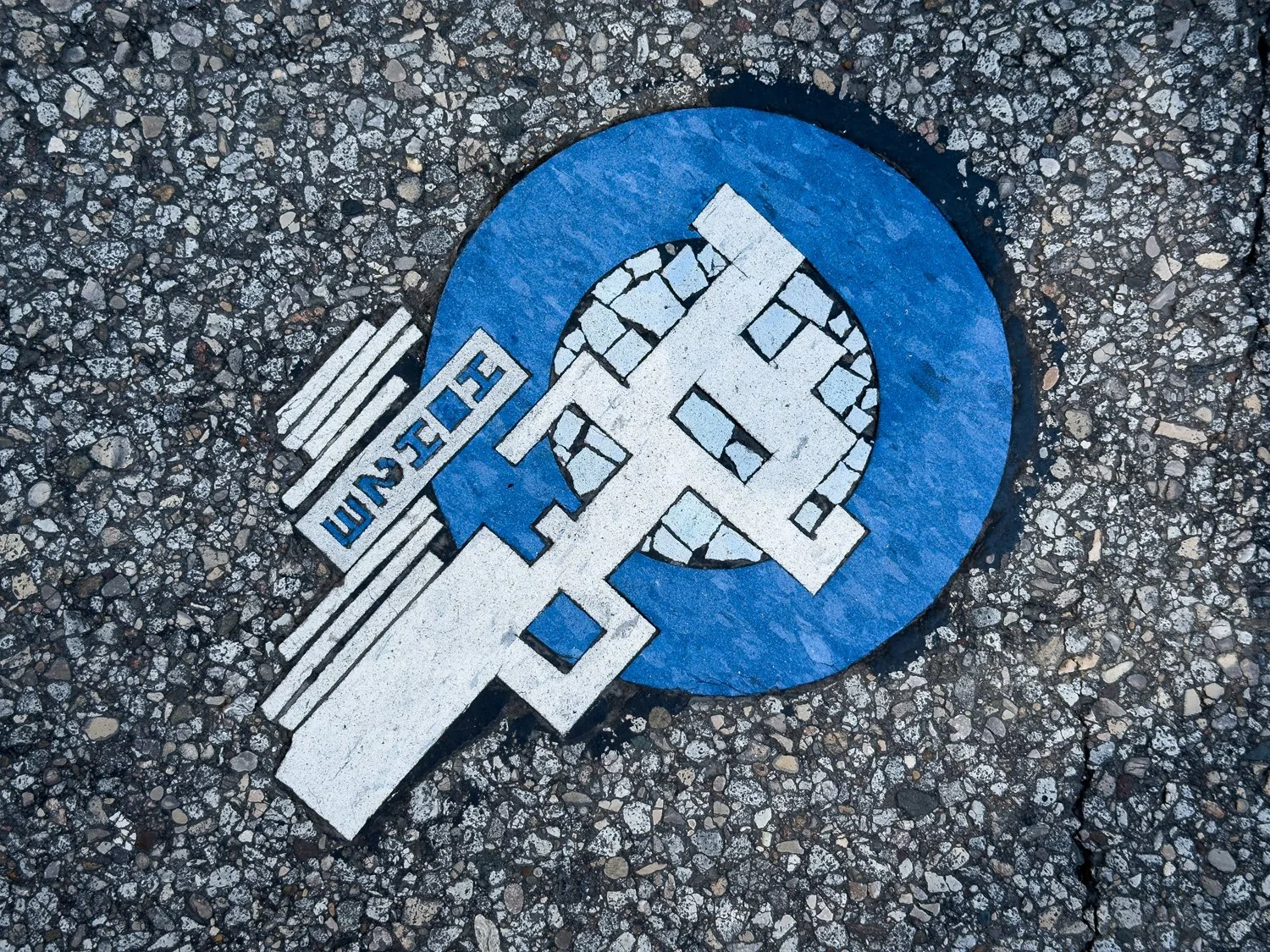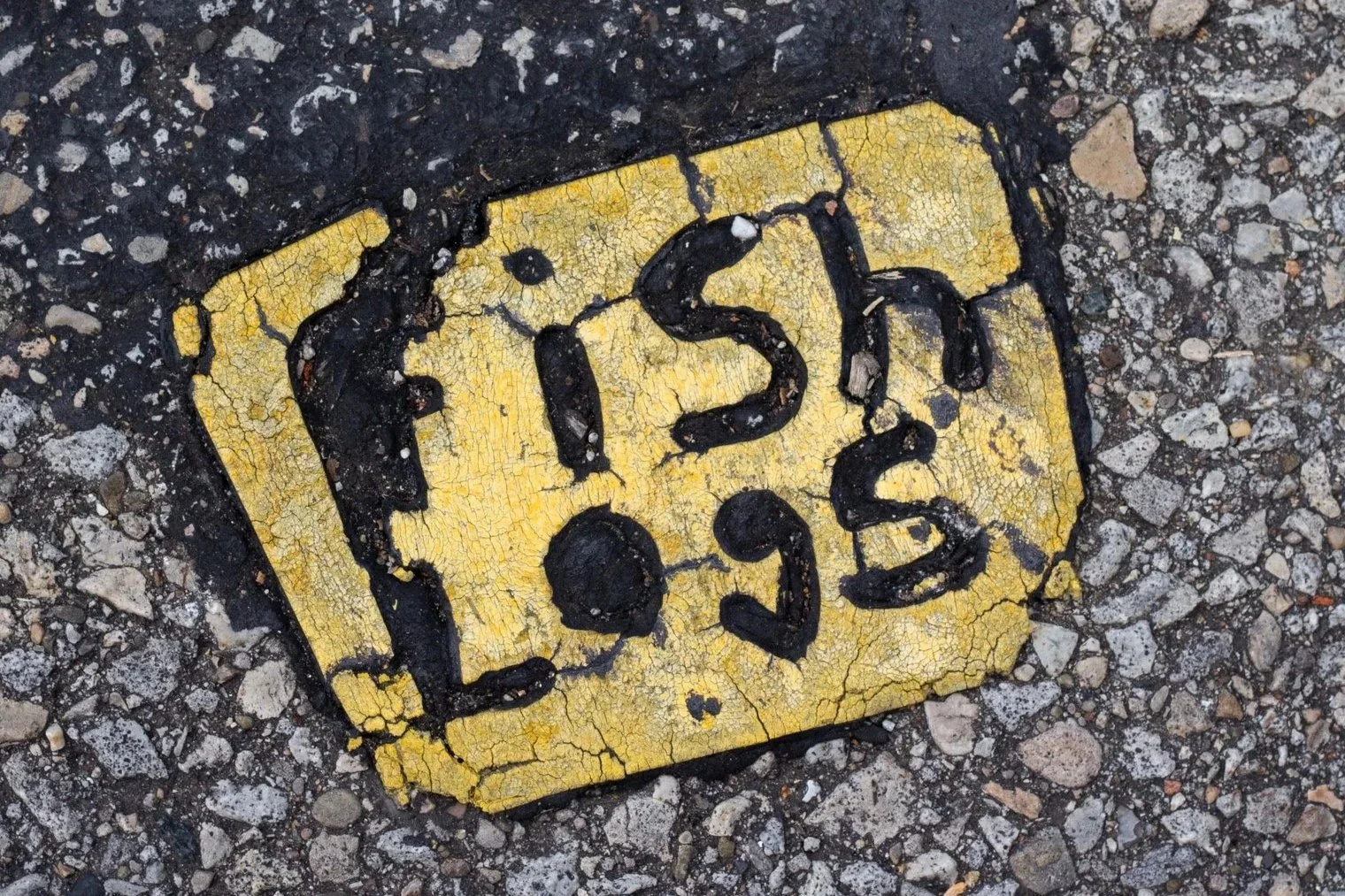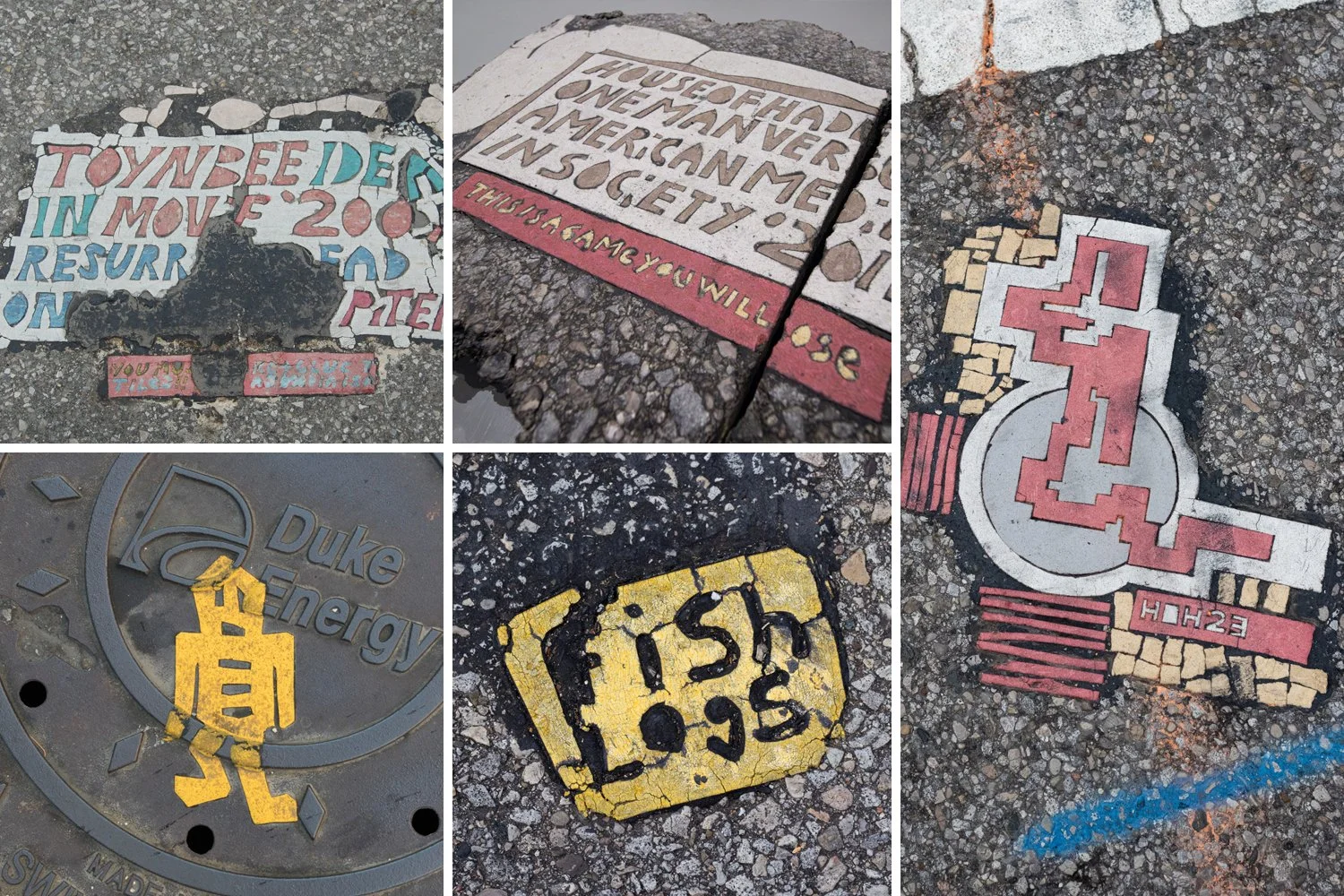3. House of Hades Returns
This story is part 3 (of 5) that ultimately leads to “A Field Guide to Street Tiles and Other Literal Street Art of the Queen City.”
I always get stopped at the same point on my ride home. It’s an intersection where an endless stream of cars and buses compete with the streetcar in an effort to get through the evening rush hour of downtown Cincinnati. The one place where I have to completely cease pedaling or balancing, and firmly plant my feet on the ground to sit it out. One day, while impatiently waiting for the light to change so that I could make it around the last corner and get on with life—I happened to glance down and see a few splashes of color with some black goo caked on top. Instantly, I knew what it was, but I still couldn’t believe it. I felt my mood shift from the banality of the everyday into excitement. There, in the asphalt beneath my sneakers, was a new Toynbee tile.
A new tile spotted in July 2023.
I mean, I knew it probably wasn’t a Toynbee tile—those seemed to have ceased awhile ago—but as I got distracted staring at the ground and the cars behind me impatiently honked: I knew it was a linoleum street art tile born of the same vein. After so many years, someone had slapped a fresh one down. So fresh, in fact, it hadn’t yet “cured.” Which, for lack of a better way to explain it means the materials used in its creation hadn’t degraded enough to reveal the full artwork. Jumping out into the crosswalk between traffic cycles, I snapped a few photographs and knelt down close enough to make out one small detail: “HOH23.”
House of Hades was back.
A House of Hades tile seen on Cincinnati’s 5th Street in 2017 and featured in the original article.
Back in 2017, I published one of my favorite stories: the one about Toynbee/House of Hades tiles. For full context, I recommend going back and reading that piece.
In the meantime, however, here’s the gist:
The original Toynbee tiles are cryptic works of street art that began appearing during the closing decades of the 20th Century. They originated—and were most prominent—in Philadelphia, but could be easily found in many major American cities such as my hometown of Cincinnati.
A standard Toynbee tile.
Image via Wikipedia.
While the design and words occasionally varied, the vast majority of tiles featured the same strange message:
TOYNBEE IDEA
IN MOVIE 2001
RESURRECT DEAD
ON PLANET JUPITER
A fantastic documentary seemingly solved the mystery of who was probably behind the tiles and what the message probably meant, but ultimately the full truth will likely never be known.
Even though I hung out in the city regularly and had a website dedicated to documenting Cincinnati, it wasn’t until the summer of 2017 when I first heard about Toynbee tiles. Instantly, I was obsessed and set out to author a story. It became clear, however, that construction work had just recently caused the demise of the city’s original tiles. Ironically, I worked for the transit authority at the time and the tiles happened to have been only on roads that had recently been torn up for our new streetcar system. I’d just missed them.
There were still some tiles, though, but these were a bit different and credited to “House of Hades.” At the time of my first story, Cincinnati had three of these House of Hades tiles still embedded within its streets.
A House of Hades tile seen on Cincinnati’s 6th Street in 2017 and featured in the original article.
House of Hades’ work first spotted in Buffalo before spreading across the country. Several of the Cincinnati HOH examples specifically reference 2011 and I later came across one in Nashville credited to that same year.
A House of Hades tile seen in Nasvhille, 2018.
While my 2017 story became a personal favorite, I certainly wasn’t the first to notice the street title phenomenon. Aside from those who’d produced the aforementioned documentary, there were several others across the internet who’d been cataloging these things. Cincinnati was no exception and maybe no Queen City local had taken as much notice over the years as my friend Bob Schwartz (a.k.a. 5chw4r7z). Every time Bob and I ran into each other or grabbed a beer, the subject of the Toynbee/House of Hades tiles would come up. We even once hatched a plan to make our own and set off to gather the materials and learn the process.
At first glance, the technique of creating a tile seemed straightforward enough. Our issue, though, that we couldn’t find the main ingredient. Essentially, the tiles themselves are crafted from linoleum and then coated in tar paper and asphalt sealant. Once dropped onto a roadway, the heat of the sun and constant pressure from traffic will eventually adhere the linoleum into the pavement. After the tar and sealant wear away: what’s revealed is an embedded message. We came to learn, though, that only “real,” old-school linoleum works and what’s readily available today is some sort of hybrid or vinyl imitator.
Bob managed to get his hands on some of the good stuff, but found it incredibly hard to cut around. Eventually, with a newfound respect for those who’d created the tiles, we abandoned plans for our own. A couple of good friends in the Die Innenstadt supporters group did recently make a Toynbee tile-inspired banner to display at FC Cincinnati matches, however:
A banner inspired by the Toynbee tiles that’s regularly on display at FC Cincinnati matches.
Image via Jeremy Schulz.
As the years wore on, Cincinnati’s House of Hades pieces faced the usual threats to a street tile’s existence: construction and weather. One was partially removed during some 2018 roadwork and I managed to snag it/ship it back to an artist who had collaborated with House of Hades.
A piece of a Cincinnati Hades tile that was removed. The full story of its fate can be found here.
Another was disfigured after a pothole formed around it in the winter of 2022/2023:
Much like the original Toynbee tiles and their creator, House of Hades and the person/persons behind them remain mostly a mystery. Tile expert and a main fixture of the documentary, Justin Duerr, has met “House of Hades,” but the artist’s motivations and messages seem to be best gleaned from the tiles themselves rather than conversation.
What is certain, is that House of Hades is still active. Within recent years, new tiles have been spotted in Buffalo, Syracuse, New York, Pittsburgh, and as of this year: Cincinnati. The one I stumbled upon with my bike apparently wasn’t the only new one to debut in the streets of the Queen City. 5chw4r7z had noticed several others and on a recent afternoon: we hopped on our bikes and began criss-crossing the city.
All in all, we located six (EDIT: now, seven (EDIT 2: make that, eight (EDIT 3: nine (EDIT: ten)))) new tiles—most of which are still “curing.” In the coming weeks, once the adhering materials are finally worn away, the tiles will become more clear. They don’t seem to carry messages in the same way that their ~2011 predecessors did, rather, they appear to be more akin to visual works of art. As they become more clear, though, who knows what they’ll reveal.
Three previous House of Hades tiles remain from the artist’s original visit (presumed to have been around 2011):
This particular tile was partially removed during some roadwork. The missing piece was shipped back to a House of Hades collaborator.
This tile has become very worn down since I originally photographed it in 2017.
Mentioned previously, this tile was disfigured by the emergence of a pothole and subsequent roadway repair.
5chw4r7z and I plan keep an eye out in the coming weeks to see how these new ones develop, but in the meantime—if you spot any others around town: let us know. We did our best to keep our eyes peeled, but after awhile everything on the street starts to look like a tile—whether it’s utility caps, sewer grates, pothole patches, or dead rats.
To House of Hades (just in case you’re reading this): thanks for coming back. If you’d ever like to talk, we’d be glad to buy you a few cold beers while hearing your story.
Update | September 5, 2023:
Came across one more while riding home this evening. Either we missed it on the first pass, or, it’s relatively fresh:
Update | September 22, 2023:
While walking out of a coffee shop a few days ago, I was crossing the street when I looked down and happened upon number eight:
Update | October 24, 2023:
While walking the dog today, happened upon number nine:
Update | August 18, 2025:
Somehow, we missed number ten back in 2023:
All 2023 House of Hades Tiles:
See more detailed photographs and information in “A Field Guide to Street Tiles and Other Literal Street Art of the Queen City.”
Next Chapter:
In Cincinnati's Northside neighborhood, street tiles have begun to appear. Similar to their “Toynbee” and “House of Hades” cousins, this new variant references a former neighborhood bar's signature dish.
All “Street Tile” Posts:
Since 2007, the content of this website (and its former life as Queen City Discovery) has been a huge labor of love.
If you’ve enjoyed stories like The Ghost Ship, abandoned amusement parks, the Cincinnati Subway, Fading Ads, or others over the years—might you consider showing some support for future projects?





























